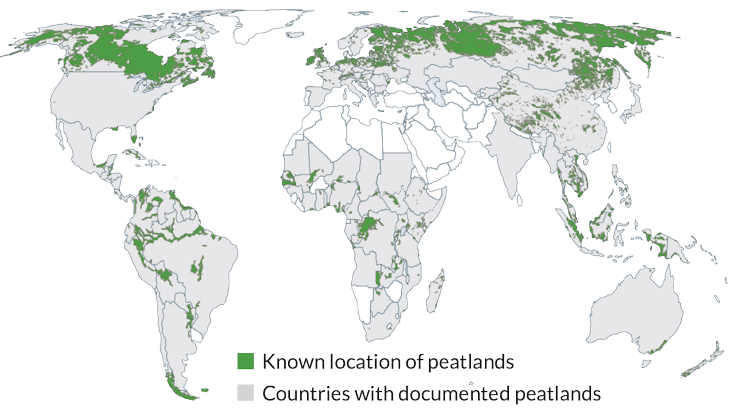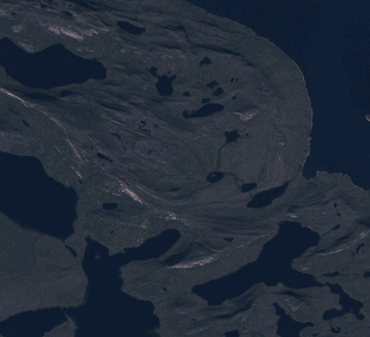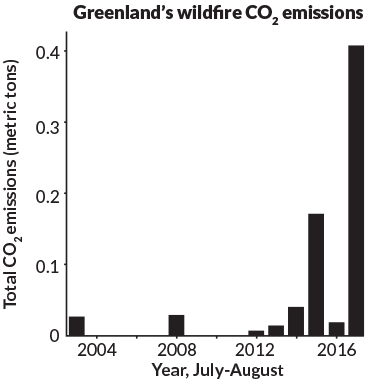When bogs burn, the environment takes a hit
The peat sequestered in the wet ground keeps much of Earth’s carbon out of the atmosphere
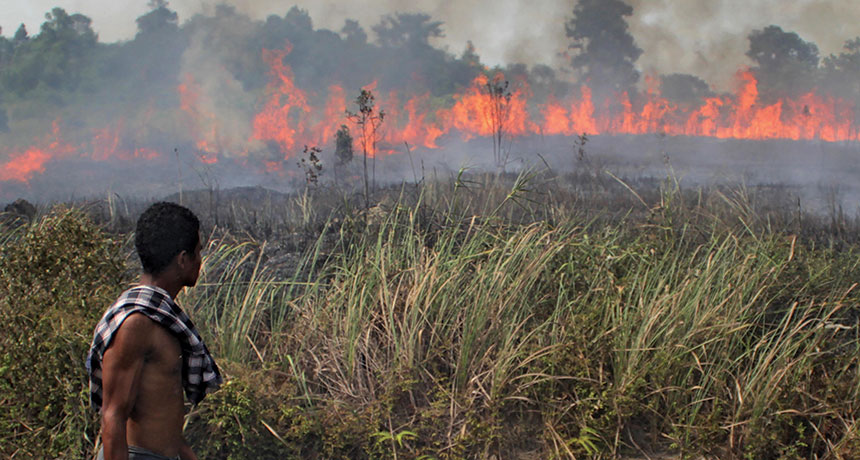
SMOKE SIGNALS Peatland fires in Riau Province, Indonesia, burned in August 2016, releasing stored carbon into the atmosphere. Climate change and agriculture are putting peatlands at risk.
Zuma Press Inc./Alamy Stock Photo
In 2015, massive wildfires burned through Indonesia, sending thick smoke and haze as far as Thailand.
These fires were “the worst environmental disaster in modern history,” says Thomas Smith, a wildfire expert at King’s College London. Smith estimates that the fires and smoke killed 100,000 people in Indonesia and neighboring countries and caused billions of dollars in damage. The fires were costly for the rest of the planet, too: At their peak, the blazes belched more climate-warming carbon dioxide into the atmosphere each day than did all U.S. economic activity.
Two years later and 13,000 kilometers away, a fire smoldered on the fringes of a barren, northern landscape. The remote blaze could have gone unnoticed. But Jessica McCarty and other fire researchers actively monitor satellite imagery of Earth the way some people check Facebook. One Sunday in August, McCarty, of Miami University in Ohio, was surprised to see massive plumes of what appeared to be white smoke over a swath of Greenland. The giant landmass had not been on her fire radar. It’s mostly ice, and the parts that aren’t have sparse vegetation.
The settings of these two blazes couldn’t have been more different, but scientists suspect the two had something important in common: plenty of decaying organic matter known as peat.
Peatlands — which include bogs, other swampy wetlands and, yes, Greenland’s icy soil — are ecosystems rich in decayed organic matter.
In their healthy, soggy state, peatlands are quite fire resistant. So when it comes to fire risk, peat-heavy landscapes haven’t historically gotten the same attention as, say, the dry pine forests of the western United States. But with those devastating peat fires in Indonesia, the spotlight has turned to the planet’s other peatlands, too.
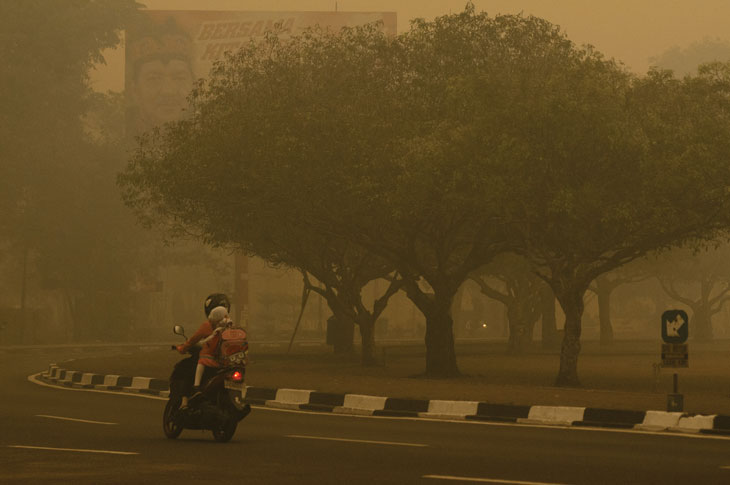
Worldwide, peatlands store massive amounts of carbon in thick blankets of wet organic matter accumulated in the ground over centuries. And though they cover just 3 to 5 percent of Earth’s land surface, peatlands store a quarter of all soil carbon. That adds up to more carbon than all of the world’s forests combined.
But changes in land use — draining the water to plant acres of crops that demand drier soil, a common practice in tropical regions, or building a road through an area — can dry out the peat. And then, a single carelessly tossed cigarette or an errant lightning strike can ignite a fire that will smoke and smolder for months, releasing thousands of years of stored carbon as carbon dioxide into the atmosphere.
Or fires set to clear land for agriculture can get out of hand, like they’ve done in Indonesia: Over the last few decades, the country has drained many of its peatlands to grow oil palms and other crops. Now, the country is seeing the worst-case scenario of what can happen when peatlands are disrupted and desiccated. In northern latitudes, meanwhile, thawing permafrost exposes peat that has been buried for years, which can fuel fires like those seen in Greenland last summer.
In the short term, peat fires clog the air with deadly smoke and smog. In densely populated areas such as Indonesia, blazes can devour homes and businesses and claim lives. But the fires’ impact lingers long after the flames die down. Peat fires reshape entire ecosystems. Once the peat burns away, it can take thousands of years to build up again. And all of the carbon that was once neatly stored away is instead floating around in the atmosphere, contributing to climate change much like burning coal does.
Now, scientists are trying to get a better handle on peatlands and the effects of agriculture, development and a climate that’s shifting toward warmer and drier. Recent discoveries of hidden peatlands in Africa and South America expand the extent of peat around the world, and up the stakes for protecting those carbon stores. New research is making it increasingly clear that, without a shift in approach, humans might strip away healthy peatlands and get, in return, a lot of climate-warming carbon dioxide.
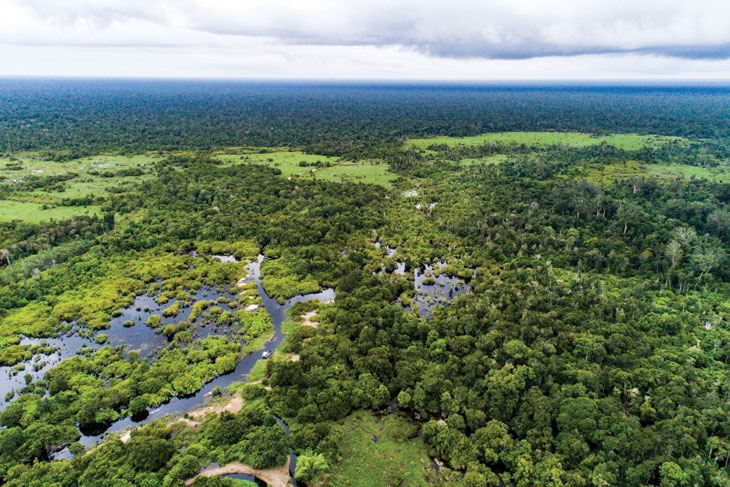
Meet peat
Bogs don’t conjure warm, fuzzy feelings for most people. The landscapes are often associated in popular culture with witches, Europe’s mummified “bog bodies” and dreary weather. It’s perhaps telling that “quagmire” — another word for a bog — is also used to refer to a sticky predicament. But to the scientists who study them, bogs are far from bleak.
“Most people walk far, far out of their way to avoid walking through these things, but I love them,” says Merritt Turetsky, a peat researcher at the University of Guelph in Canada. The bogs that she studies in Canada and Alaska look like “hobbit ecosystems,” she says, with all of the action happening low to the ground: stunted trees studding a colorful carpet of mosses and lichens. And, she points out, bogs play a crucial role in keeping our planet healthy.
Carbon is constantly being recycled throughout the world: It’s taken in by plants as carbon dioxide, for example, and is dissolved in the oceans. But excess circulating carbon can throw ecosystems out of whack. Too much carbon dioxide in the atmosphere makes the planet heat up; too much dissolved in the ocean makes the water more acidic. Long-term carbon stores in ocean sediments and rocks such as limestone pull carbon out of the short-term cycle, cloistering it where it can’t do harm. The same goes for peatlands; dig down many meters into a bog, and you’ll find carbon that’s been buried for thousands of years.
And while the untrained eye might look at a bog and see nothing but a soggy morass that calls for waterproof waders, peatlands can be surprisingly diverse. In the tropics, where swamp forests are filled with large, leafy trees, blankets of peat are typically built up by decayed woody plants. Temperate peatlands, like those in the northern United States and Canada, sport scrubbier vegetation and are made mostly from decayed sphagnum moss.
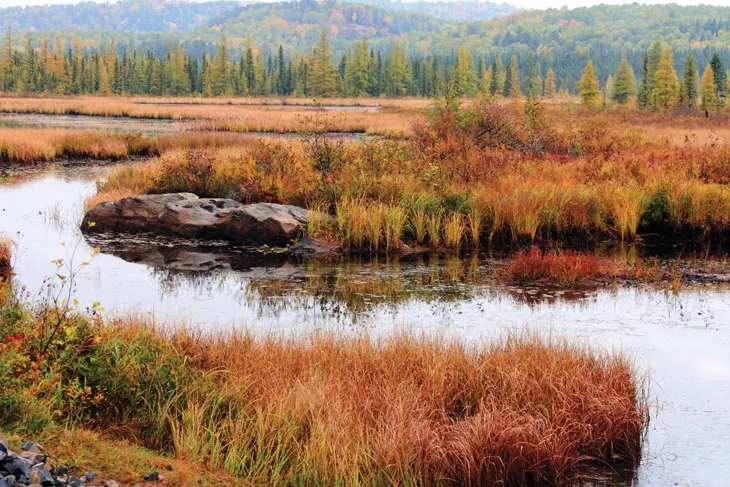
Peat is “not exactly nonrenewable, but it accumulates so slowly,” Turetsky says. “A fire can burn through a dry bog and literally release thousands of years of carbon in a couple minutes of combustion.” She learned that firsthand as a graduate student.
Almost 20 years ago, she buried small bags of peat in a Canadian bog to study their decomposition. When she returned two years later to dig up the samples, her entire field site had gone up in smoke. Her precious data were gone.
“I was devastated for about a day,” Turetsky says. “But then I started thinking about it: We were shocked that this system had burned.”
The very next day, she started collecting new data, this time observing how the bog recovered from the fire. Back then, she says, people assumed that the only thing slowing down the accumulation of peat was its inevitable natural decomposition over time. “It was the first time I realized that decomposition wasn’t the only process leading to peat loss,” Turetsky says. “Fire also reduces peat by combusting it.”
Hidden deposits
With an increased awareness of the threats to bogs has come a greater push to identify and protect the resources contained in these ecosystems. Recently, large new peat-rich spots have been discovered around the world. In January 2017, British and Congolese scientists announced in Nature that huge tracts of peat have been hiding in a lush expanse of forest straddling the equator in the Central Congo Basin. The area is home to groups of indigenous people but difficult for outsiders to access, so nobody had surveyed its peat resources until recently.
The researchers, led by Simon Lewis and Greta Dargie of University College London and the University of Leeds in England, trekked into the basin to extract “cores” to measure how deep the peat went in dozens of places. Based on those long cylindrical cross sections of soil, the researchers calculated that the peat deposits found in the jungle, some as deep as 5.9 meters, boost the global estimated amount of peat in the tropics by 36 percent. Then the team used satellite data to measure the boundaries of the peat. From there, the researchers estimated that the carbon stored in Central Congo Basin’s peat is equivalent to about 20 years of fossil fuel emissions from the United States, at current rates.
Other groups have quantified existing peatlands remotely. A study published in August 2017 in Global Change Biology used data on where water accumulates and how it flows across the landscape to predict where peat might be hiding in tropical regions.
The analyses suggest that South America may be home to far more peat than previously known. A network of smaller peatlands in the Amazon Basin adds up to 629,000 square kilometers, an even larger area than the Congo find, says study coauthor Louis Verchot of the International Center for Tropical Agriculture in Cali, Colombia. This newfound South American peat plus the Congo area and some new finds in Asia boost known tropical peatlands from 440,000 square kilometers to 1.5 million.
Logging and mining already threaten the carbon stored in the trees of tropical forests. The peat-rich soil has value as well.
Out of balance
When dug up, peat is inherently flammable and is used in some places as a source of fuel. But in their natural, wet state, peatlands are resistant to fires. Even after months of drought, healthy peatlands stay moist. So scientists are trying to understand what factors change that dynamic — and what that means for fires and carbon storage.
It can be hard to test the effect of drying over time in a controlled way, but in one instance, Turetsky got lucky. In 1983, part of a fen, or marshland, in Alberta, Canada, was drained for a forest management project. The water table dropped roughly a quarter of a meter, a moderate amount. Eighteen years later, a wildfire burned in the area.
Turetsky and colleagues saw an opportunity for a natural experiment to answer a few open questions. The researchers tracked how drainage followed by fire affected the peatland over time, compared with areas that burned but weren’t drained or parts that were drained but didn’t burn.
The drained area was far more vulnerable than the undrained area to big changes after a fire, the researchers reported in 2015 in Scientific Reports. The combination of drainage and wildfire invited different plant species to move in over the next decade. The new plants changed the ecosystem from fire-resilient to one that was liable to burn again and again. And the leafy canopy of the broadleaf trees that took up residence in place of the once-dominant black spruces blocked out the sunlight necessary for peat-producing mosses to return.
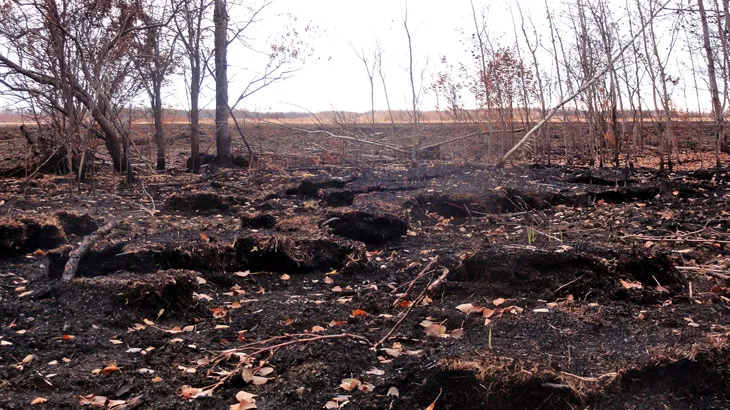
The change Turetsky saw, from a fairly modest disturbance, was much bigger than she expected. She knew that completely drying out such a landscape would make it extremely fire-vulnerable — dramatic changes like those seen in Southeast Asia. But the change in the Alberta fen was much smaller, and yet still had a substantial effect.
Compared with areas that hadn’t been drained, the areas that had been drained lost almost 500 more years’ worth of accumulated peat, she says. (She calculated the figure based on the amount that burned and the rate at which peat accumulates.) That’s 500 additional years of locked-away carbon released back into the atmosphere in a matter of weeks.
Farming’s future
Draining the land plus “slash and burn” techniques to clear areas for agriculture are the main reasons that tropical peatlands are catching fire, says Alexander Cobb, an environmental scientist at the Singapore-MIT Alliance for Research and Technology. To make room for oil palm plantations and other crops, companies will raze existing trees (the source of future peat) and drain the water to dry out the soil.
In 2017, 139 scientists signed a letter to the editor in Global Change Biology arguing that draining tropical peatlands for agriculture is unsustainable. Denying the effects that agriculture has on these landscapes will have long-term consequences, such as more frequent and more devastating fires, the researchers wrote.
Now, Indonesia is working to restore its peatlands. It’s not as simple as prohibiting crops in peat-rich areas, though. In densely populated island nations, space is at a premium and people still need to eat, says Susan Page, a tropical bog expert at the University of Leicester in England and one of the letter’s signers. Solving the problem might require finding crops that can grow in soggier soil so bogs wouldn’t have to be drained. But solutions are a long way off.
“A lot of the economic support for alternative crops doesn’t really exist yet,” Page says. “We’re in the in-between stage of knowing we want crops but not having a suitable list of species.”
Even in places where peatlands are protected from agriculture, there are other potential threats. Cobb and colleagues spent months figuring out how to bushwhack through dense trees with exposed roots as tall as a human to reach a rare, untouched peatland in Brunei, a small, wealthy Southeast Asian nation that Cobb says has been more proactive about protecting its peatlands than neighboring countries. The researchers plunged measuring devices into the soil to determine the depth of peat and how wet it was. With those data, the team created a model of the way rainfall affects the amount of peat that can build up in any particular place, published last June in Proceedings of the National Academy of Sciences.
The conclusion: Along with total rainfall, timing of that rainfall matters. If rainfall becomes more irregular, as it’s predicted to in the future, “then with the same average rainfall, the peatland can support less peat,” Cobb says.
Safe if frozen
Peatlands in cold places face challenges in a changing climate, too. In northern latitudes, including the Arctic, peat has been entombed for centuries in permafrost. Arctic warming is now exposing that peat, raising the risk of once-uncommon fires.
Last summer’s Greenland fire is one such example. When McCarty spotted what she thought was a fire, she posted the satellite data on Twitter. Over the coming weeks, she and other scientists virtually checked in on the fire multiple times each day, becoming convinced that the smoke was fueled by peat.
For one thing, there’s very little vegetation in the region that could provide fuel. Peat in the soil was one of the few options. Plus, the fire lingered for several weeks, but barely traveled. That’s very characteristic of a peat fire, McCarty says. If the fire’s not moving, it’s probably smoldering, slowly burning through dense organic matter with a lot of smoke and minimal flames.
Scientists have not scoped out the Greenland fire site in person, says Guillermo Rein, a fire scientist at Imperial College London. But he’s part of a team that’s trying to organize an expedition to the remote area, to study the soil and confirm that peat was the fire’s main driver.
Arctic peat has what Rein calls “dormant flammability.” That is, when it’s frozen, it’s safe. But if the permafrost begins to thaw, these long-entombed carbon stores are exposed to the air and suddenly vulnerable to burning.
It would be easy to dismiss the Greenland fire as a one-off event, a fluke. But really, it’s just one match in a whole box. Peat blazes have been recorded in Alaska and Siberia, as well as across Canada. Evidence suggests that fires like these will become more common. The National Oceanic and Atmospheric Administration’s annual Arctic Report Card, released December 12, showed that ground-level air in the Arctic is warming twice as fast as the global average surface air temperature. By the end of this century, carbon release from Arctic burning is likely to quadruple, according to a 2016 study in Environmental Research Letters. Plus, fires and permafrost thaw can start a feedback cycle that hastens future thawing, McCarty says.
The precise long-term consequences of such thawing on peat stores in the Arctic are still unclear. While peat emerging from frozen permafrost initially dries and cracks, the area might eventually flood and rewet as ice melts elsewhere, according to a 2015 paper in Scientific Reports. But until then, the dried-out peat is a fire risk.
These Arctic and high-latitude peat fires might not immediately affect as many people as tropical peat fires, because for the most part the fires aren’t in agricultural hot spots or urban centers. But the global consequences, in terms of carbon release, could be just as severe.
Some researchers expect that as climate change pushes agriculture and human populations farther north, “people are going to come more in contact with these mostly pristine landscapes” and disturb them in ways that could increase fire risk, Page says. In Canada, she says, “decades down the line, we could see a similar fire dynamic as we’re seeing in Southeast Asia” — uncontrolled fires causing irreparable damage to long-term carbon stores.
“There’s more and more talk in the north about draining northern soils,” Turetsky adds. “We already know what’s going to happen.”
This article appears in the March 17, 2018 issue of Science News with the headline, “Smoke Signals: Burning peatlands have environmental researchers on alert.”
